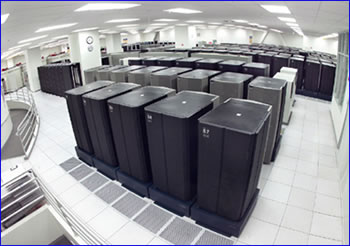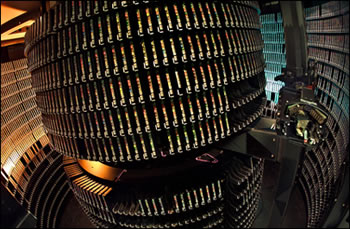|
|
 |
BERKELEY, CA — The National Energy Research Scientific
Computing (NERSC) Center, funded by the U.S. Department of Energy's Office
of Science, put its 10 teraflops-per-second (10 trillion calculations
per second) IBM supercomputer into service last week, providing researchers
across the country with the most powerful computer for unclassified research
in the United States.
|
 |
|
| The most powerful unclassified supercomputers in
the United States are in service at NERSC. |
|
The IBM supercomputer, which comprises 6,656 processors, entered production
a month ahead of schedule, meaning that the system will provide up to
4 million more processor hours of computing time in the current fiscal
year. The NERSC Center, located at Lawrence Berkeley National Laboratory,
serves more than 2,000 researchers at national laboratories and universities
across the country.
In November, the NERSC Center announced that its next supercomputer to
be deployed would be a doubling of its existing IBM, which then had 3,328
processors. By taking this cost-effective approach, the NERSC Center was
able to more quickly meet the demands of its national user community and
do it with a computer architecture they were already using.
"Our partnership with IBM continues to pay significant dividends
for our users, who are taking advantage of the increase in computing power
to analyze and simulate scientific problems of greater complexity and
size," said NERSC Center Division Director Horst Simon. "With
increasing demand for computing time from research groups in DOE's SciDAC
program (Scientific Discovery through Advanced Computing), being able
to provide a much larger yet robust system is critical. This is a very
cost-effective way to accelerate scientific discovery throughout DOE Office
of Science research programs."
Before putting the expanded IBM into production on March 3, NERSC thoroughly
tested it by running both scientific codes and benchmarking applications.
The system was available more than 98 percent of the time during testing,
and a NERSC Center team ran benchmarks that ran at 72 percent of peak
speed, much higher than that achieved on similar parallel systems.
"IBM designs systems that are equally as at home running corporate
databases as they are solving complex
scientific problems," said Surjit Chana, IBM eServer pSeries vice
president. "With the IBM supercomputing
power, NERSC will have the scalability, speed, and performance to continue
making strides in solving the most
challenging problems."
|
 |
|
| One of the storage silo robots in NERSC's 8.8-petabyte
High Performance Storage System (HPSS) |
|
The new system will include 7.8 terabytes of aggregate memory and a Global
Parallel File System with 44 terabytes of storage. The system will be
supported by NERSC's High Performance Storage System (HPSS), which provides
8.8 petabytes of archival data storage capacity.
The NERSC Center is the flagship supercomputing center for unclassified
research sponsored by the Office of Science in DOE. Currently, some 2,100
scientists use NERSC's supercomputers to research problems in combustion,
climate modeling, fusion energy, materials science, physics, chemistry
and computational biology. Established in 1974, the NERSC Center has long
been a leader in providing systems, services and expertise to advance
computational science.
Berkeley Lab is a U.S. Department of Energy national laboratory located
in Berkeley, California. It conducts unclassified scientific research
and is managed by the University of California.
Additional information
|

